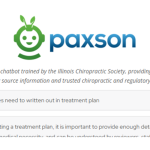
Removing Interferences to Your Revenue Cycle System

[Editorial Note: Brandy Brimhall is the COO of Practisync, a wholly-owned subsidiary of the ICS that delivers quality billing (and other) services to chiropractic physicians. Find out more about Practisync here.]
As doctors and chiropractic assistants (CA), you communicate to your patients how interferences in their nervous system are often a cause or contribute to physical signs, symptoms, or more problematic conditions for which they may be seeking care. You educate patients that, if these interferences are untreated and unmonitored, the effects can become more severe, take more time and treatment to improve or repair, and can even cause new conditions that didn’t exist before.
However, with routine evaluation and appropriate care, these signs and symptoms are minimized or eliminated, and more challenging conditions are improved or sufficiently managed, allowing the patient to function more optimally with less or minimal nervous system interference.
I believe that the outstanding care that chiropractic practices render to their patients makes up the “heartbeat” of the practice. After all, without patients, there is no practice. To use a similar analogy: in my view, the revenue cycle system is essentially the “nervous system” to the practice. In other words, interferences in the revenue cycle system are the result of numerous signs, symptoms, and conditions related to practice cash flow, collections, and even time management. Here are just a few:
- Rejected or denied claims
- Over-the-counter collections uncertainties
- Inability to properly communicate with patients regarding financial responsibilities
- Aging accounts receivable balances, including patient and insurance balances
- Stifled cash flow and collections
- Practice workforce uncertainties and frustrations
- Loss of valuable provider or CA time tending to revenue cycle challenges
- Audit and compliance-related vulnerabilities
As with the body and nervous system, the revenue cycle system has many possible causes and effects of interferences, as well as many areas/regions in the system where this can occur. Likewise, each area of the revenue cycle system is closely connected to one or more others, increasing the likelihood of interferences occurring in other places as well, particularly if the system is neglected or improperly maintained.
Sufficiently understanding the many parts to your revenue cycle system and periodically evaluating each of them serve as great diagnostic tools for your practice. On a broad scope, let’s take a look at a few of the most commonly encountered revenue cycle system interferences or causes for them:
Interference 1: A Single Gatekeeper
Only one person who knows what to do, when tasks should be done, and how to accomplish them.
This scenario creates immeasurable vulnerabilities to providers because they are extending a blind trust in the financial health of their entire practices, even those with a superstar CA at the helm of these processes. When that CA moves on or takes time off, the many keys to the revenue cycle system go with them.
Interference 2: Poor Baton Passing
It takes weeks and sometimes several months to really learn and become comfortable with some job duties. The many parts of the revenue cycle system are certainly no exception. Adding an additional team member or replacing an existing team member generally relies on brief person-to-person training, which results in misunderstanding, confusion, essential skipped components, limited-to-no checks and balances, important elements slipping through the cracks, etc. In many cases where adequate understanding and training are critical, the baton simply doesn’t get passed or is simply just dropped without anyone even realizing it until incoming collections and cash flow are restricted, leaving the practice to worry about what happened, when, and how.
Interference 3: Insufficient or Absent Training
Many CAs find that they must create their own systems and procedures, often without the tools and resources that would be necessary to give them certainty and confidence in their job. Sometimes those in charge of billing and collections didn’t even realize that was going to be their role when they were hired. They have limited to no understanding of coding requirements, what’s necessary for clean claims and submission, how payor policies and network requirements apply, the necessity of state law knowledge for both insurance and self-pay patients, and more. Often when asking why something is done a certain way, I am told, “We just do it this way because that’s what we’ve always done.”
In this scenario, CAs often feel a lack of confidence in their own performance, and perhaps even know that there are missing pieces, but have nowhere to go with questions and concerns. The result: billing-and-collection errors, uncertainty in what or how to communicate with patients about finances, loss of practice money and time, potentially higher rates of staff turnover, etc.
Interference 4: Lack of Understanding of the Many Parts to the Revenue Cycle System
The revenue cycle system is quite complex, far more than simply just billing and collecting. Consider the following components:
- insurance verifications,
- electronic and paper claims,
- federal payors,
- Personal Injury and Work Comp payors,
- patient financial communications,
- over-the-counter collections,
- rejection management,
- claims processing and posting,
- in-/out-of-network guidelines,
- patient invoicing,
- non-covered or alternative treatment procedures,
- correct coding,
- claims review and posting,
- self-pay patients,
- appeals,
- follow-up, and
- aged receivable management, etc.
This limited list of revenue cycle system components often brings to the surface many questions and concerns that practices have in one or more of these areas. It’s very easy to get stuck in the daily mechanics of data entry and billing, while many of the crucial components to the revenue cycle system are set to the side, forgotten about, or never even fully understood.
Interference 5: Time Management Challenges
There are so many hats that most CAs in a practice wear on a day-to-day basis. Even the most talented CAs can find themselves constantly playing catch-up, with a growing to-do list for which there never seems to be enough time. In this scenario, it is often those revenue cycle-related tasks that may be more time-consuming that are set to the side and left unattended.
Interference 6: Insufficient Billing, Collections, and Accounts receivable systems
Unattended or poorly attended systems will result in a growing restriction of cash flow. The older the balance (from patients and payors), the more difficult it becomes to collect and the more costly it becomes to the practice. Motion is a sign of life – water, air, blood, and even cash flow. Stagnant monies in billing, collections, and accounts receivable systems have many long-term effects on a practice. These interferences minimize growth, expansion, workforce confidence, efficiency, patient relationships, practice overall value, financial health, and more.
In my office, I work with practices every day to help identify and remove those revenue cycle system interferences. In some cases, practices are aware of where interferences are occurring but need assistance to establish necessary action steps for a productive and manageable path forward. In many other practices, we often are able to identify unknown interferences that may have been restricting cash flow for months or even years.
In most practices, these interferences are generally found to be in more than one area, and prioritizing a corrective action approach can be daunting to a practice. The good news is that improvement and correction are possible for every practice. The great news is that by properly evaluating and implementing a corrective action plan for your revenue cycle system, the stifled cash flow, compliance vulnerabilities, time-management challenges, and other symptoms or conditions your practice is experiencing, can either diminish or disappear completely. Additionally, moving forward, your practice will be able to identify new interferences more quickly as they occur and be better prepared to address them promptly with confidence.
Consider your own practice revenue cycle systems interferences, as well as the related symptoms and conditions you may be experiencing as a result. Right now is always the best time to take a proactive approach to evaluate and remove revenue cycle system interferences and freeing your practice of those restrictions that are costing you time, confidence, and money, ultimately improving the overall function of your entire practice.

















